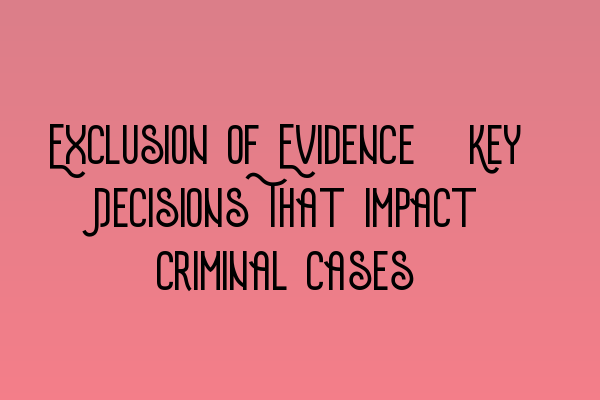Exclusion of Evidence: Key Decisions That Impact Criminal Cases
Welcome to the SQE Criminal Law & Practice Law UK blog! In this post, we will explore the critical topic of the exclusion of evidence in criminal cases. Understanding the key decisions that influence the admissibility of evidence is crucial for both aspiring solicitors preparing for the SQE exams and legal professionals seeking to stay up-to-date with developments in criminal law.
The Importance of Exclusion of Evidence
In criminal cases, the admissibility of evidence plays a pivotal role in determining the outcome of a trial. The exclusion of evidence can significantly impact the strength of the prosecution or defense, often leading to the acquittal or conviction of a defendant. Therefore, it is essential for solicitors and advocates to be well-versed in the rules and principles governing the exclusion of evidence.
As criminal law is nuanced and subject to continuous evolution, practitioners must stay abreast of key decisions that shape the admissibility of evidence. Let’s delve into some landmark cases that have had a significant impact in this area:
1. R v M’Naghten (1843)
The case of R v M’Naghten established the famous “M’Naghten Rules,” which establish the legal test for insanity in criminal cases. While this case primarily focuses on the defense of insanity, it also highlights the importance of considering mental health evidence and its potential impact on the admissibility of evidence.
For more details on how to approach defense strategies and evidence related to mental health, check out our comprehensive guide on SQE 1 Practice Exam Questions.
2. R v Turnbull (1977)
R v Turnbull addresses the importance of identification evidence and sets out guidelines for its admissibility. This case emphasizes the significance of clear and proper identification procedures, ensuring a fair trial for defendants. Understanding the rules surrounding identification evidence is crucial, as it can heavily impact the reliability of witness testimony.
Learn more about identification evidence and its implications on a criminal case in our comprehensive article on SQE 1 Practice Mocks FLK1 FLK2.
3. R v Sang (1980)
R v Sang established the “no comment” rule, which deals with the admissibility of silence in the face of police interview questioning. This case significantly impacts how the courts treat a defendant’s silence during police interviews and sheds light on the potential implications it may have on a criminal case.
For a deeper understanding of the “no comment” rule and its application in criminal proceedings, we recommend our comprehensive guide on SQE 2 Preparation Courses.
4. R v Mason (1989)
In R v Mason, the Court of Appeal set out guidelines for the admissibility of hearsay evidence. This case is of paramount importance as hearsay evidence can significantly impact the fairness and reliability of a trial. Solicitors must have a strong grasp of the rules surrounding hearsay evidence to mount an effective defense or prosecution.
For a comprehensive overview of hearsay evidence and its impact on criminal cases, explore our detailed article on SQE 1 Preparation Courses.
Stay Informed and Well-Prepared
Staying up-to-date with key decisions impacting the exclusion of evidence is vital for solicitors and aspiring SQE candidates alike. A thorough understanding of these cases enhances legal knowledge, sharpens analytical skills, and improves performance in SQE exams and legal practice.
For upcoming SQE exam dates and essential information regarding the SRA’s new assessment, visit our article on SRA SQE Exam Dates.
Stay connected with SQE Criminal Law & Practice Law UK for regular updates, insightful articles, and comprehensive preparation materials to excel in your legal journey.
